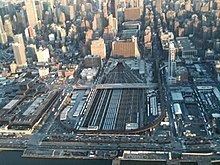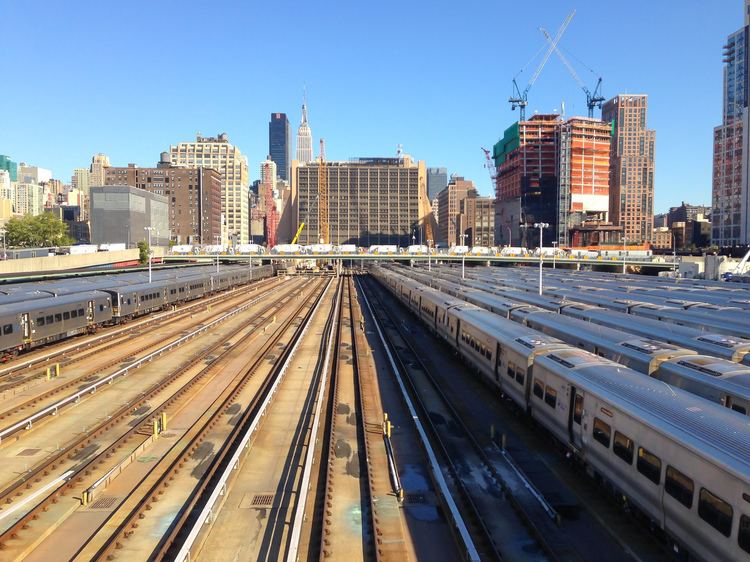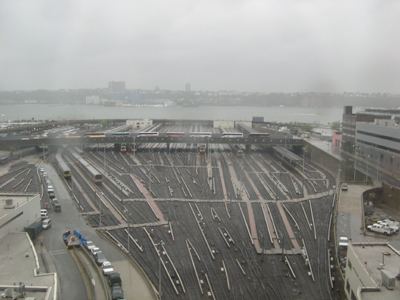 | ||
Cab ride lirr west side yard to babylon july 5 2009
The West Side Yard (officially the John D. Caemmerer West Side Yard) is a rail yard owned by the Metropolitan Transportation Authority on the west side of Manhattan in New York City. Used to store commuter rail trains operated by the Long Island Rail Road, the 26.17-acre (10.59 ha) yard sits between West 30th Street, West 33rd Street, 10th Avenue and 12th Avenue.
Contents
- Cab ride lirr west side yard to babylon july 5 2009
- Lirr west side yard storm preparations
- History
- Air rights
- Tunnel box
- References

The yard includes storage tracks, a six-track indoor shop for light maintenance, a 12-car long platform for car cleaning, and lockers and a break room for employees. The yard sits at the north end of the High Line, a former elevated rail line used for freight service that has been converted into a park, and south of the truck marshalling yard used by the Jacob K. Javits Convention Center. It also sits above the 34th Street – Hudson Yards subway station, which opened in 2015.

Before the yard opened in 1987, trains arriving at Penn Station during the morning rush hour had to deadhead back to Long Island for midday storage. The West Side Yard also increased the LIRR's peak period capacity at Penn Station.

Lirr west side yard storm preparations
History
The 26.17-acre (10.59 ha) site is bounded by between West 30th Street, West 33rd Street, 10th Avenue, and 12th Avenue. It was originally used as a depot for the Hudson River Railroad for a line running down Eleventh Avenue, as trains were not permitted to operate south of West 32nd Street because of a fear of explosions. New York Central and later Penn Central expanded the rail yards and used them as a freight terminal up until the 1970s when the company went bankrupt. The rail yard was acquired by the State of New York. The northern portion was used for construction of the Jacob K. Javits Convention Center and the southern portion became a train-storage yard used by the Long Island Rail Road (LIRR).
The yard was built because limited storage capacity at Penn Station forced LIRR trains to make non-passenger trips to storage yards on Long Island. The yard opened in 1987, immediately increasing train capacity through Penn Station. The West Side Yard is named after John D. Caemmerer, a New York State Senator from East Williston who helped obtain $195.7 million for its construction.
During construction, an underground tunnel was built that allows Amtrak trains from Penn Station to travel to Upstate New York via the West Side Line. Amtrak trains began using this tunnel on April 7, 1991; before this, Empire Service trains originated from Grand Central Terminal.
Air rights
There has been a long series of proposals to develop the rail yard air rights, including for a major expansion of Midtown Manhattan by William Zeckendorf in the 1950s and for a housing development considered by U.S. Steel in the 1960's. The West Side Yard was designed with space left between the tracks for columns to support development in air rights above the tracks. Madison Square Garden considered a possible move to the site in the mid-1980s. In the 1990s the air rights were considered as a possible location for a New York Yankees stadium. The rail yard air rights were proposed by the New York City bid for the 2012 Summer Olympics as the location for the media center, Olympic plaza, and Olympic Stadium, to be occupied afterward by the New York Jets.
The eastern portion of the West Side Yard (east of 11th Avenue) was rezoned for residential and commercial use in January 2005 as part of the Hudson Yards Redevelopment Project. Following the defeat of the proposal to construct the West Side Stadium, the western portion of the rail yard was rezoned to accommodate residential and commercial development in December 2009.
Tunnel box
The Gateway Project is a proposal to build a high-speed rail corridor to alleviate the bottleneck along the Northeast Corridor between Newark, New Jersey, and New York City. According to Schumer, the only place for an Amtrak portal for the corridor in Manhattan is in the West Side Yard. That might conflict with the Hudson Yards project, which broke ground in late 2012. In February 2013, Amtrak officials said that a right-of-way would be preserved through the Hudson Yards project by construction of a tunnel under that project using $120 million to $150 million in federal funds. In June 2013 it was announced that $183 million had been dedicated to the "tunnel box" as part of Hurricane Sandy recovery funding. Construction began in September 2013 and was expected to take two years. The underground concrete casing is 800 ft (240 m) long, 50 ft (15 m) wide, and approximately 35 ft (11 m) tall. Amtrak awarded Tutor Perini a $133m contract to build a section of box tunnel.
Amtrak, NJ Transit, and the MTA have applied to the Federal Transit Administration for a $65 million matching grant for another 105 ft (32 m) long structure to preserve the right-of-way at 11th Avenue in Manhattan under a viaduct that was rehabilitated in 2009–2011.
